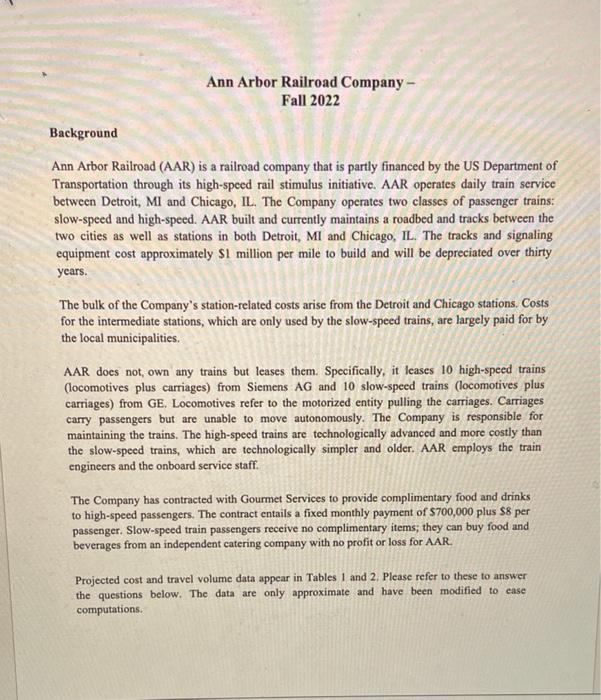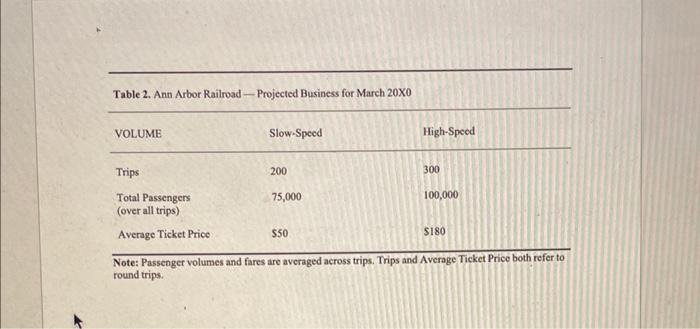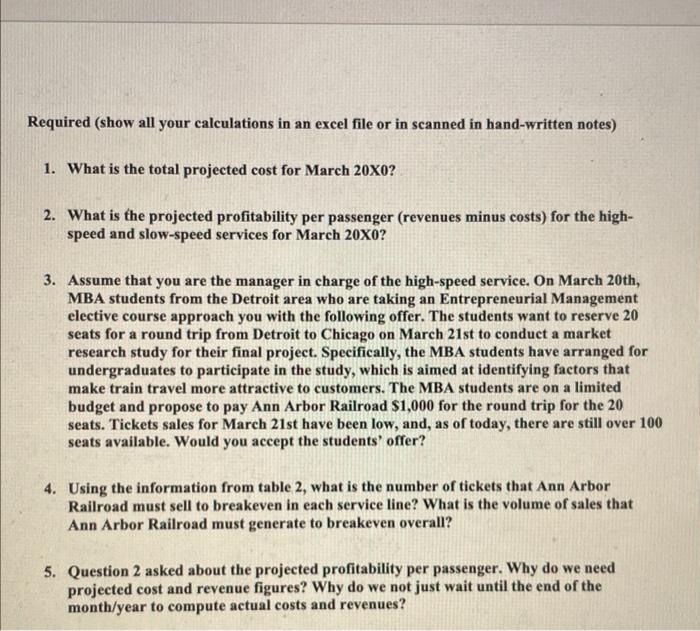Answered step by step
Verified Expert Solution
Question
1 Approved Answer
pls show work!! Background Ann Arbor Railroad (AAR) is a railroad company that is partly financed by the US Department of Transportation through its high-speed
pls show work!! 



Background Ann Arbor Railroad (AAR) is a railroad company that is partly financed by the US Department of Transportation through its high-speed rail stimulus initiative. AAR operates daily train service between Detroit, MI and Chicago, IL. The Company operates two classes of passenger trains: slow-speed and high-speed. AAR built and currently maintains a roadbed and tracks between the two cities as well as stations in both Detroit, MI and Chicago, IL. The tracks and signaling equipment cost approximately $1 million per mile to build and will be depreciated over thirty years. The bulk of the Company's station-related costs arise from the Detroit and Chicago stations. Costs for the intermediate stations, which are only used by the slow-speed trains, are largely paid for by the local municipalities. AAR does not, own any trains but leases them. Specifically, it leases 10 high-speed trains (locomotives plus carriages) from Siemens AG and 10 slow-speed trains (locomotives plus carriages) from GE. Locomotives refer to the motorized entity pulling the carriages. Carriages carry passengers but are unable to move autonomously. The Company is responsible for maintaining the trains. The high-speed trains are technologically advanced and more costly than the slow-speed trains, which are technologically simpler and older. AAR employs the train engineers and the onboard service staff. The Company has contracted with Gourmet Services to provide complimentary food and drinks to high-speed passengers. The contract entails a fixed monthly payment of $700,000 plus $8 per passenger. Slow-speed train passengers receive no complimentary items; they can buy food and beverages from an independent catering company with no profit or loss for AAR. Projected cost and travel volume data appear in Tables 1 and 2. Please refer to these to answer the questions below. The data are only approximate and have been modified to ease computations. Table 1. Ann Arbor Railroad - Projected Cost for March 20X0 Table 2. Ann Arbor Railroad - Projected Business for March 20X0 Note: Passenger volumes and fares are averaged across trips. Trips and Average Ticket Price both refer to round trips. 2. What is the projected profitability per passenger (revenues minus costs) for the highspeed and slow-speed services for March 20X0? 3. Assume that you are the manager in charge of the high-speed service. On March 20th, MBA students from the Detroit area who are taking an Entrepreneurial Management elective course approach you with the following offer. The students want to reserve 20 seats for a round trip from Detroit to Chicago on March 21 st to conduct a market research study for their final project. Specifically, the MBA students have arranged for undergraduates to participate in the study, which is aimed at identifying factors that make train travel more attractive to customers. The MBA students are on a limited budget and propose to pay Ann Arbor Railroad \$1,000 for the round trip for the 20 seats. Tickets sales for March 21st have been low, and, as of today, there are still over 100 seats available. Would you accept the students' offer? 4. Using the information from table 2, what is the number of tickets that Ann Arbor Railroad must sell to breakeven in each service line? What is the volume of sales that Ann Arbor Railroad must generate to breakeven overall? 5. Question 2 asked about the projected profitability per passenger. Why do we need projected cost and revenue figures? Why do we not just wait until the end of the month/year to compute actual costs and revenues 



Step by Step Solution
There are 3 Steps involved in it
Step: 1

Get Instant Access to Expert-Tailored Solutions
See step-by-step solutions with expert insights and AI powered tools for academic success
Step: 2

Step: 3

Ace Your Homework with AI
Get the answers you need in no time with our AI-driven, step-by-step assistance
Get Started


